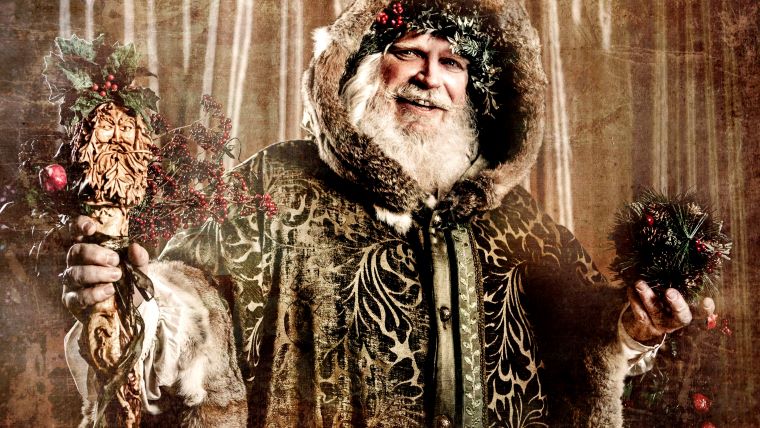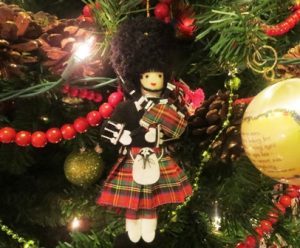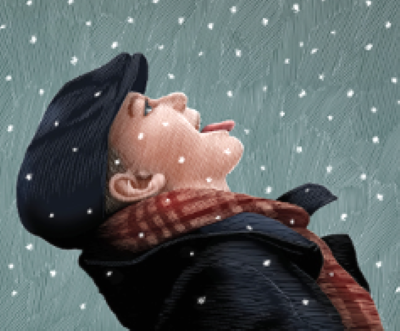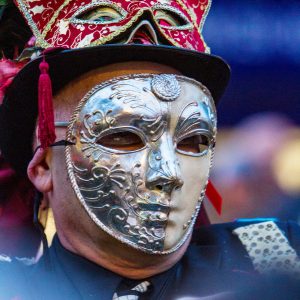
According to longstanding theory, the origins of Christmas stem from pagan winter festivals. One main reason early Christians were able to spread their religion across Europe so quickly came from their willingness to embrace celebrations prevalent among regional populations.
One such example is the Celtic ‘Alban Arthuan,’ a Druidic festival that took place around December 21st, the Winter Solstice. This traditional fire festival celebrated the re-birth of the Sun.
Although a celebration of the Son’s birth replaced that of the Sun’s, a number of Christmas-tide traditions – including those the ancient Celts practiced – remain today.
As we look at the Celtic nations, it is interesting to note some similarities among Christmas traditions that cross geographic boundaries. They include, for example: Holly (a symbol of rebirth among Pagan Celts, but also of hospitality—it was believed fairies sought shelter inside the evergreen leaves to escape the cold); Mistletoe (believed to have healing powers so strong that it warded off evil spirits, cured illnesses and even facilitated a truce between enemies); fire and light (most notably the Yule log or candles placed in windows to light the way for strangers and symbolically welcoming Mary and Joseph); and door-to-door processions, from wassailing to Wren Hunts.
Each of the seven nations possesses its own variations of Celtic Christmas customs. Surrounding cultures and local identify shape theses practices as well.
SCOTLAND
Christmas was not officially recognized in Scotland for nearly four centuries. The Puritan English Parliament banned Christmas in 1647 and it did not become a recognized public holiday in Scotland until 1958.
However, according to Andrew Halliday, in his 1833 piece Christmas in Scotland, Scots were not discouraged from celebrating Christmas. Halliday wrote, “We remember it stated in a popular periodical, one Christmas season not long ago, that Christmas-day was not kept at all in Scotland. Such is not the case; the Scots do keep Christmas-day, and in the same kindly Christian spirit that we do, though the Presbyterian austerity of their church does not acknowledge it as a religious festival.”
 Halliday’s 19th century account went on to describe festive sowens (sweetened oat gruel) ceremonies, “beggars” (actually “strapping fellows”) singing yule song, dances and card parties and children’s teetotum games.
Halliday’s 19th century account went on to describe festive sowens (sweetened oat gruel) ceremonies, “beggars” (actually “strapping fellows”) singing yule song, dances and card parties and children’s teetotum games.
Despite Puritan rule, some long-time Christmas traditions are preserved. These include burning the Cailleach (a piece of wood carved to look like an old woman’s face or the Spirit of Winter) to start the new year fresh; or on Christmas Eve burning rowan tree branches to signify the resolution of any disputes. The Celtic tradition of placing candles in windows was also done in Scotland to welcome “first footers” (strangers, bearing a small gift) into the home.
Traditional dishes also continue to be featured at Christmas lunch and throughout the holidays, including Cock-a-Leekie soup, smoked salmon, beef or duck, Clootie dumplings, black buns, sun cakes, Christmas pudding and Crannachan.
Because Christmas was not an official holiday until the late ‘50s it is no surprise that today, for some Scots, Hogmanay (New Year’s Eve) is the most important event of the season. Arguably, locals ring in the new year with much more gusto than any other place on the planet.
IRELAND
A fall-time cleanup was a common practice in Irish homes to prepare for Christmas. Women looked after cleaning the interior, while men took care of the outdoors, including whitewashing all exterior surfaces. Then holly, grown wild in Ireland, was spread throughout the house with cheer. Contemporary Ireland also highlights this clean-up ritual; once complete, fresh Christmas linens are taken out of storage.
Other customs include the Bloc na Nollaig or Christmas Block (the Irish version of the Yule log), candles in the window (perhaps one for each family member), and leading up to Christmas, “Calling the Waites,” where musicians would wake up townspeople through serenades and shouting out the morning hour.
Christmas Eve Mass is still a grand affair; a time for friends and family to reconnect. It is not uncommon for churchgoers to end up at the local pub after service to ring in Christmas morn.
 On Christmas Day, traditional dishes include roast goose or ham and sausages, potatoes (such as champ), vegetables (such as cabbage with bacon) and plum pudding, whiskey, Christmas cake and barmbrack (currant loaf) for sweets.
On Christmas Day, traditional dishes include roast goose or ham and sausages, potatoes (such as champ), vegetables (such as cabbage with bacon) and plum pudding, whiskey, Christmas cake and barmbrack (currant loaf) for sweets.
Traditionally on December 26th, St. Stephen’s Day, Wren Boys with blackened faces, carrying a pole with a dead bird pierced at the top, tramped from house to house. Today the custom sometimes sees children caroling throughout the neighbourhood to raise money for charity. It is also quite common to go out visiting on this day.
One modern-day Irish tradition to note is gathering around the television to watch the “The Late Late Toy Show” in late November/early December, said to be the most watched program in Ireland.
WALES
Dylan Thomas’ story A Child’s Christmas in Wales is renowned around the world. An excerpt offers a glimpse of a traditional Welsh festive season:
“Always on Christmas night there was music. An uncle played the fiddle, a cousin sang ‘Cherry Ripe,’ and another uncle sang ‘Drake’s Drum.’… Looking through my bedroom window, out into the moonlight and the unending smoke-coloured snow, I could see the lights in the windows of all the other houses on our hill and hear the music rising from them up the long, steady falling night.”
Music was and still is a major part of Welsh holidays. Plygain is a Christmas day church service, traditionally held between three and six a.m., featuring males singing a capella in three or four-part harmonies. While today this may be mainly practiced in rural areas, Eisteddfodde (caroling) is abundantly popular in homes, door-to-door and as part of annual song-writing competitions.
Other intriguing Welsh traditions include toffee making; drinking from a communal wassail bowl of fruit, spices, sugar and beer; children visiting homes on New Year’s Day looking for their Callenig gift; and Mary Lwyd (Grey Mare) featuring wassail singers going door-to-door carrying a horse’s skull and challenging residents in a contest of mocking rhymes.
ISLE OF MAN
Caroling also holds a special place in Manx Christmas celebrations, but traditionally an unconventional twist characterized it. On Christmas Eve, large numbers attended church for Carval. While the congregation sang, all of a sudden women would begin the traditional food fight, having peas on hand to throw at their male counterparts!
Accounts from the 1700s and 1800s describe 12 days of non-stop Christmas celebrations where every barn was filled with dancers accompanied by fiddlers the local parish hired.
“On the twelfth day the fiddler lays his head on one of the women’s laps, which posture they look upon as a kind of oracle,” recorded Reverend John Entick (as published in 1774). “For one of the company coming up and naming every maiden in the company, asks the fiddler, who shall this or that girl marry? And whatever he answers it is absolutely depended on as an oracle.”
 As in Celtic fashion, Hunting the Wren processions occurred on the Isle of Man and today the practice is going through a revival, characterized by costumes, singing and dancing.
As in Celtic fashion, Hunting the Wren processions occurred on the Isle of Man and today the practice is going through a revival, characterized by costumes, singing and dancing.
Other Manx customs include Mollag Bands, wearing eccentric clothing, swinging a mollag (fishing float) and demanding money (a practice since outlawed); the kissing bush (a more elaborate ornament than a sprig of mistletoe); and Cammag, a sport that originated on the Isle of Man traditionally played on December 26th and/or Easter Monday.
Finally, in older times but even as recently as the early 20th century, Christmas decorations were not taken down until Pancake Tuesday (when they were burnt under the pancake pan). Now holiday décor tends to be packed away on Old Christmas (January 6th).
CORNWALL
As a result of Oliver Cromwell banning Christmas, authentic holiday carols began to fade through much of Britain. However, throughout the 1800s, Cornish composers and collectors sparked a revival of local Christmas song.
“Contrary to the effect Methodism might have had on the English carolers, in Cornwall its impact was to stimulate song,” states the Cornwall Council (Cornish Christmas Carols – Or Curls, 2011). “In those areas where Methodism was strongest, music and signing had their greatest appeal, and notably so at Christmas. The singers would practice in chapels and school-rooms, some of them walking miles to be there.”
Certain carols well-known around the world, such as Hark the Herald Angels and While Shepherds, are credited to Cornish origins.
Today, Cornwall erupts in festivals, fairs and markets during the holidays. The Montol Festival in Penzance (named for Montol Eve on December 21st) is a six-day celebration highlighting many Cornish traditions. These include Mummers plays, lantern processions, Guise dancing (participants dress in masks and costume, such as mock formal dress, to play music and dance).
Montol is also the time for burning the Mock (yule log). A stickman or woman is drawn on the block of wood with chalk. When the log burns, it symbolizes the death of the old year and birth of the year to come.
BRETAGNE
Bretagne boasts a wealth of folklore and supernatural beliefs around Christmas time. Christmas Eve was known as a night of miraculous apparitions from fairies to Korrigans, and at midnight, for just a brief moment, waters in the wells would turn into the most sweet-tasting wine. It was also at midnight, when families were either at mass or in bed, that ghosts would surface; traditionally food was left out for deceased loved ones just in case they visited.
During the holidays, Christmas markets come alive in many Breton towns vending hand-made crafts and toys, baked cakes and bread and ingredients for Christmas dinner. You can also buy Gallette des Rois at stalls, as well as bakeries, which is traditionally eaten on January 6th (Epiphany). A tiny figurine (the fève) is hidden inside the puff pastry cake; the person who finds the figurine in their piece gets to be king or queen for the day and wear a crown. Another special tradition through all of France is a meal after Christmas Eve’s midnight mass, called Réveillon. Specifically in Bretagne, the traditional dish for this occasion is buckwheat crêpes with cream.
 GALICIA
GALICIA
Galicia has its own unique Christmas gift-bearer that predates Christianity. He is called Apalpador, a giant who lives in the mountains. For Christmas, he descends into the villages below to make sure each child has a full belly. He brings treats, such as chestnuts, and well wishes for a year full of delicious sustenance. While Apalpador may not be widely observed in Galicia, his legend is seeing a revival.
Food is very important during the Galician holidays, featuring at least two feasts (on Christmas Eve and Christmas Day). Not surprisingly, seafood is on the menu, including lobster, prawns, shrimp, sea bass, and cod with garlic and paprika sauce. Other culinary delights consist of cured meat, cheese and bread, roast beef with vegetables and for dessert tarta de Santiago (almond cake), filloas (stuffed pancakes) and turrones (nougats).
Throughout all of Spain, including Galicia, children anticipate the coming of the Three Kings or Magis who fill their shoes, left out on Epiphany Eve (January 5th) with gifts. Many Galician municipalities also host a parade featuring the Kings.




















Leave a Comment